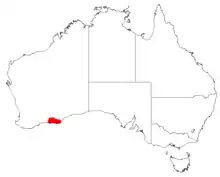| Elkhorn coneflower | |
|---|---|
| Scientific classification | |
| Kingdom: | Plantae |
| Clade: | Tracheophytes |
| Clade: | Angiosperms |
| Clade: | Eudicots |
| Order: | Proteales |
| Family: | Proteaceae |
| Genus: | Isopogon |
| Species: | I. alcicornis |
| Binomial name | |
| Isopogon alcicornis | |
 | |
| Occurrence data from Australasian Virtual Herbarium | |
Isopogon alcicornis, commonly known as the elkhorn coneflower,[2] is a plant in the family Proteaceae and is endemic to part of the South Coast Western Australia. It is a low shrub with pinnately-lobed leaves and oval heads of hairy, white or pink flowers.
Description
Isopogon alcicornis is a shrub that typically grows to a height of about 45 cm (18 in) and has hairy pale brown to gray branchlets. The leaves are mostly pinnately lobed with two to five flat lobes, linear to lance-shaped and 10–40 cm (3.9–15.7 in) long on a petiole up to 15 cm (5.9 in) or sometimes longer. The flowers are arranged in sessile, oval or elliptic heads up to 40 mm (1.6 in) in diameter on the ends of branchlets, each head with hairy, pink flowers often hidden by the leaves. There are hairy, spatula-shaped involucral bracts at the base of the flowering head. Flowering mainly occurs from October to November and the fruit is a hairy nut, fused in an oval head up to 25 mm (0.98 in) in diameter.[2][3]
Taxonomy
Isopogon alcicornis was first formally described in 1903 by Ludwig Diels in Botanische Jahrbücher für Systematik, Pflanzengeschichte und Pflanzengeographie.[4][5]
Distribution and habitat
Elkhorn coneflower grows in low shrubland on the near Esperance and on Mount Baring near the Cape Arid National Park in the south-west of Western Australia.[2][3]
Conservation status
This isopogon is classified as "Priority Three" by the Government of Western Australia Department of Parks and Wildlife[2] meaning that it is poorly known and known from only a few locations but is not under imminent threat.[6]
References
- ↑ "Isopogon alcicornis". Australian Plant Census. Retrieved 19 November 2020.
- 1 2 3 4 "Isopogon alcicornis". FloraBase. Western Australian Government Department of Biodiversity, Conservation and Attractions.
- 1 2 Foreman, David B. "Isopogon alcicornis". Australian Biological Resources Study, Department of Agriculture, Water and the Environment: Canberra. Retrieved 19 November 2020.
- ↑ "Isopogon alcicornis". APNI. Retrieved 19 November 2020.
- ↑ Diels, Ludwig (1904). "Fragmenta Phytographiae Australiae occidentalis. Beitrage zur Kenntnis der Pflanzen Westaustraliens, ihrer Verbreitung und ihrer Lebensverhaltnisse". Botanische Jahrbücher für Systematik, Pflanzengeschichte und Pflanzengeographie. 35 (1): 134–136. Retrieved 19 November 2020.
- ↑ "Conservation codes for Western Australian Flora and Fauna" (PDF). Government of Western Australia Department of Parks and Wildlife. Retrieved 19 November 2020.
